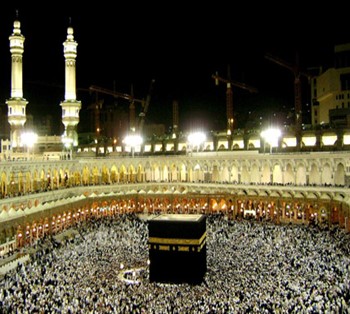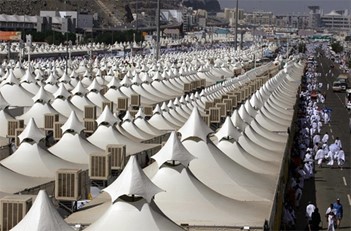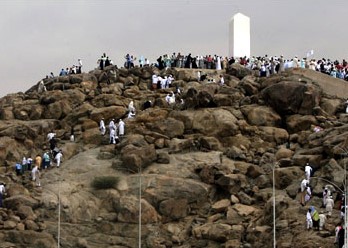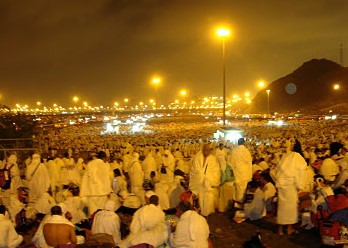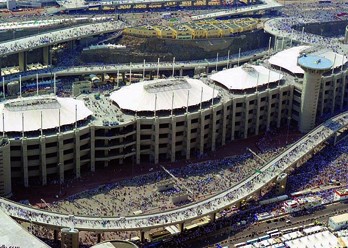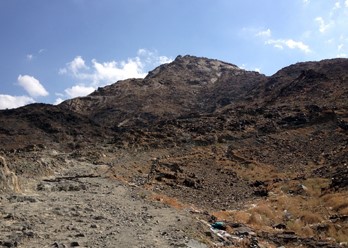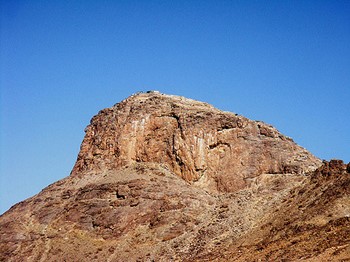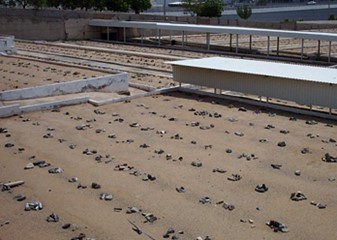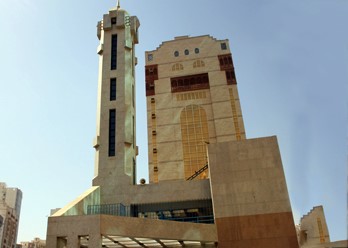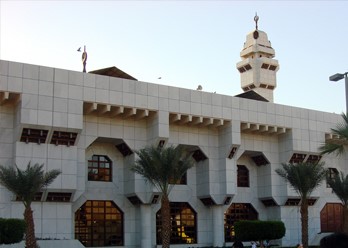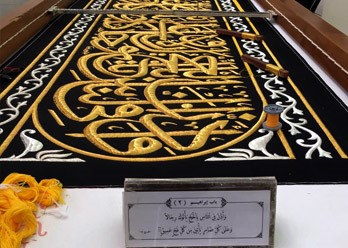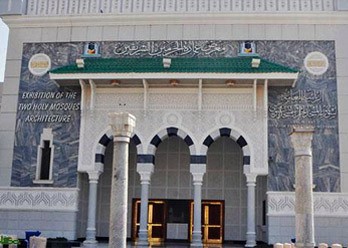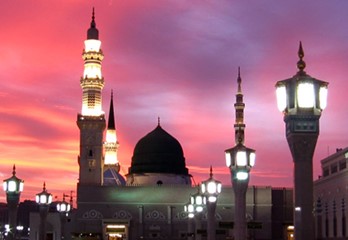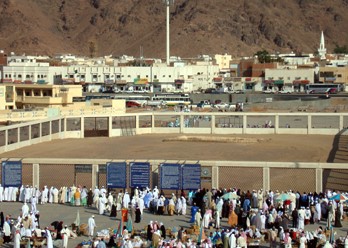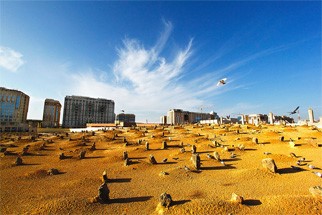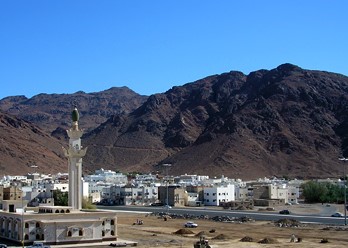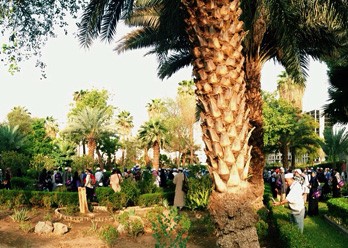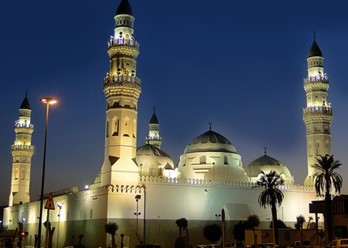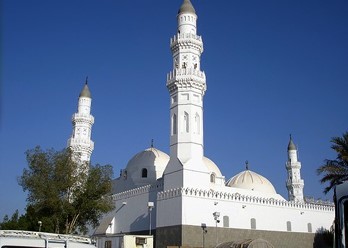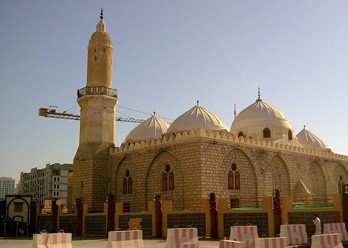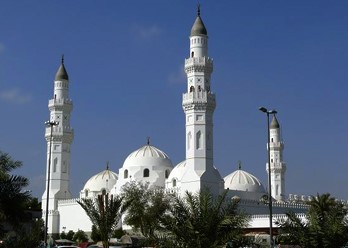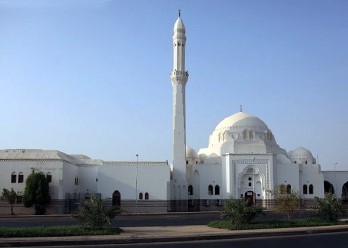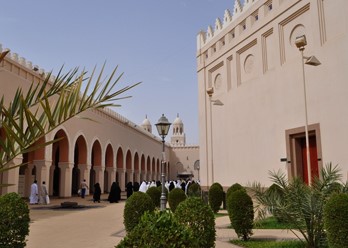Beyond Umrah
Other Places to visit in the Holy cities (Makkah & Madinah) – Mazarat
MAKKAH
|
Makkah (مكه) Makkah is regarded the holiest city in Islam and a pilgrimage to it known as the Hajj is obligatory for all able Muslims. Makkah is home to the Kaaba, by majority description Islam's holiest site, being the direction of Muslim prayer. Makkah has seen tremendous expansion in size and infrastructure, home to structures such the Abraj Al Bait, also known as the Makkah Royal Clock Tower Hotel, the world's third tallest building and the building with the largest amount of floor area. Today, more than 15 million Muslims visit Makkah annually, including several million during the few days of the Hajj. As a result, Makkah has become one of the most diverse cities in the Muslim world, despite the fact that non-Muslims are prohibited from entering the city.
|
|
|
MINA (منى)
Mina is a valley 5 km towards East of Makkah. During Hajj, the pilgrims stay in this valley on 8th of Dhul Hajj and then on 10th to 13th of Dhul Hajj. Mina is best known for the role it plays during the annual Hajj pilgrimage also known the “tent city”. More than 100,000 air-conditioned tents provide temporary accommodation to visiting pilgrims. In the valley of Mina is the Jamarat Bridge, the location of the ritual of the Stoning of the shatan, performed between sunrise and sunset on the last day of the Hajj. Mina is the place where pilgrims throw stones, commemorating the occasion that the Prophet Ibrâhîm stoned the shatan that came between him and the command Allah had set him. |
|
|
MOUNT OF RAHMAH (جبل الرحمة) Arafa’ or Arafat is a valley about 20 km outside Makkah. On the 9th of Dhulhaj, it is mandatory for all the pilgrims to reach and stay in the valley of Arafa’ and spend the day in making dua’s, doing dhikr and forgiveness for all their sins from Allah; failing which can invalidate their hajj. JabaluRahamah or the Mount of Mercy is a mountain in the valley of Arafat. It is about 70 m high. Our Prophet SAW stayed on this mountain and made waqoof. Masjid e Nimra is a beautiful mosque. Two thirds of this mosque lie in the valley of Arafat while one third in the valley of Nimra and the valley of Urana’. Nowadays, the Sermon of Hajj is delivered in Masjid e Nimra. Our Prophet (peace and blessings of Allah be on him) delivered the Sermon of Hajj while sitting on his camel (Quswa) in the valley of Urana’.It is mandatory for the pilgrims to offer Qsr and combined prayers of Dhur and Asr after the Sermon of Hajj in or around Masjid e Nimra, and then reach the valley of Arafat and make waqoof there, spending their time in making dua’s, dhikr and Madinah king for forgiveness. Arafat is the best place to make dua; 9th of Dhulhija is the best time to make dua and the best dua to make according to one hadith is: It is better to make dua in the valley of Arafat while facing Qibla and raising your hands. If a person is late in reaching the valley of Arafat, but manages to spend some time waqoof during the night between 9th and 10th of Dhulhija before Fajr, his Hajj is validated. It is sunnah not to fast on the 9th of Dhulhijj if you are a pilgrim. However, if you are not a pilgrim, then fasting on 9th of Dhulhijj is preferred and expiates all the sins of the previous year for the next year, according to one hadith. References: [1] Sahih Muslim, Kitab ul Hajj, Hadith: 1218 [2] Tirmidhi, Kitab udda’waat, Hadith : 3585
|
|
|
MUZDALIFAH (مزدلفة) Muzdalifah is situated in the province of Makkah. It is mostly a flat land and lies between Mina and Arafat. The pilgrims travel from Mina to Arafat on the 9th of DhulHijjah. They spend the whole day at Arafat and after sunset, they leave for Muzdalifah without offering the Maghrib prayer, all the while reciting talbiyah. When pilgrims reach Muzdalifah, they can stay where ever they are. At Muzdalifah, the pilgrims sleep in open air and wake up early for fajr prayer. There is hill in Muzdalifah known “Mashar-ul-Haram”. It also has a mosque built on it. It is Sunnah to make dua near Mashar-ul-Haram while facing Qibla. Nowadays, the starting and ending boundary lines for Muzdalifah have been highlighted properly so that the pilgrims know the area in which they are required to spend the night and to make duas. According to one hadith narrated by Arwa (RA), anyone who is able to offer fajr salah in Muzdalifah, has accomplished his Waqoof-e-Muzdalifah. Soon after fajr prayer, the pilgrims leave for Mina. For the very old, sick or children, it is allowed to leave Muzdalifah after the moon sets down, before the time of Fajr prayer starts. Usually the pilgrims collect pebbles for stoning the Jamarat at Muzdalifah. However, the pebbles for Our Prophet (peace and blessings of Allah be on him) were collected by Ibn Abbas (RA) from Mina. There is a valley between Mina and Muzdalifah, called Wadi Muhasser. It was here that the army of Abraha and his elephants met the punishment of Allah (SWT), the incident which is mentioned in the Surah Feel of Quran. |
|
|
JAMARAT (الجمرات) The jamarat or stoning the Shaitan (devil) is an important part of Hajj. Jamarat were at first three tall pillars in Mina, but since 2004, they have been replaced by high walls to avoid accidents. Moreover a (one way) bridge has been made to make it easy for the Hujjaj (pilgrims) to pelt the Jamarat either from the bridge or from the ground. The three walls or Jamarat are named ; Jamarah-al-Oola or Jamarah-e-Sughra (meaning the first or the small Jamarah), Jamarah-al-Wusta (meaning the middle Jamarah) and Jamarah-al-Uqbah or Jamarah-al Kubra ( meaning the last or the largest Jamarah). Haj is an Ibadah that is a collection of rituals that commemorate the Sunnahs of Ibraheem (AS) and his family. Pelting the Jamarat represents the steadfastness of Ibraheem (AS) and Isma’eel (AS). When Ibraheem (AS) saw a dream for three consecutive nights that he was sacrificing his only son at the time, he knew that a Prophet, his dreams were true and a form of Wahi (revelation). So he took his son, Isma’eel (AS) along him. On their way, he told his son about the dream. The son readily agreed to be sacrificed to please Allah. Ibraheem (AS) and Isma’eel (AS) were walking towards Mina, they were approached by Shaitan. It tried to persuade Ibraheem (AS) not to sacrifice Isma’eel (AS). Shaitan appeared before Ibraheem(AS) three times at the points the Jamarat stand now. All three times he was pelted with stones by Ibraheem (AS) to ward him off and he remains steadfast on his decision to sacrifice his son. When Ibraheem tried to sacrifice Isma’eel (AS), Allah was mightily pleased with him. Ibraheem (AS) was sent a Ram from heaven to be sacrificed instead of Isma’eel (AS). So, the Hujjaj pelt stones at Jamarat to commemorate the Sunnah of Ibraheem (AS). References: [1] Surah Madinah-Saffaat 37: verse -102 - 107
|
|
|
GHAR THAWR (غار ثور) When the Prophet (S.A.W.) and Abu Bakr (R.A.) arrived at the cave on Mount Thawr, for three consecutive nights the Prophet (S.A.W.) and Abu Bakr (R.A.) remained hidden in the cave. During the hijrah from Makkah to Madinah When they were inside Allah (SWT) sent a spider to spin a web from a bush across the entrance to the cave. Allah (SWT) also commanded two doves to fly down between the spider and the tree, make a nest and lay eggs. Meanwhile the Quraysh search party scoured the area south of Makkah where the Prophet (S.A.W) and Abu Bakr (R.A.) where hiding. They came upon the mouth of the cave, and had they looked down while standing at the edge of the cave, they would have surely found the men they were hunting. With the Quraysh so close to discovering their hiding place, Abu Bakr (R.A.) became very tense about the Prophet (S.A.W.)’s safety. The Prophet (S.A.W.) reassured him, “How can you be apprehensive about two with whom is a third, especially when the third one is Allah?” On seeing the spider’s web and dove nest, the Quraysh concluded that no one could have entered the cave and left. Describing this scene the Quran mentions in Surah Taubah |
|
|
GHAR HIRA (غار حراء) It was here that the Prophet Muhammad (S.A.W.) received the first revelations of the Holy Quran during the month of Ramadhan in 610 CE. The mountain is also known Jabal Noor (the mountain of light). The Prophet (S.A.W.) first began to have revelations in the form of good dreams which came true. Then he began to like solitude. He would go to the cave of Hira and meditate there in solitude for a number of days and nights. He would take provisions with him to stay for an extended period, and when he returned to Khadeejah (R.A.), he would stock up again and go back to the cave. This was his practice until Truth was revealed to him by an angel while he was in the cave of Hira. During Tahajjud time one night, when he was alone in the cave, there came to him an angel in the form of a man. The angel said to him, “Recite!” “I cannot read”, the Prophet (s.a.w.) replied. The angel took hold of him a second time and pressed him until he could not endure it any longer. After letting him go, the angel again said, “Recite!” Again the Prophet (S.A.W.) replied “I cannot read”. The angel further embraced him again until he had reached the limit of endurance and said “Recite!” for the third time the Prophet (S.A.W.) said “I cannot read”. The angel released him and said: “Read in the name of your Lord, the Creator. He Who created man from a clot. Read! And your Lord is the Most Bounteous. Who taught by the Pen, taught man what he knew not.” [96:1-5]
|
|
|
JANNAT UL MALA (مقبرة المعلى) Several members of the Prophet (S.A.W.)’s family and many Sahabah (R.A.) are buried here. The following personalities are buried in this graveyard: Ummul Mu’mineen Khadeejah (R.A.), the first wife of the Prophet (S.A.W.) Qasim, the eldest son of the Prophet (S.A.W.) from his wife Khadija (R.A.); he died in infancy. Abdullah, the second son of the Prophet (S.A.W.) from his wife Khadija (R.A.) Abu Talib – the uncle of the Prophet (S.A.W.) Abdul Muttalib – the grandfather of the Prophet (s.a.w.)
|
|
|
MASJID AL JINN (مسجد الجن) Masjid Jinn built on the place where the Prophet (S.A.W.) drew a line for Abdullah bin Mas’ood (R.A.) who had accompanied him after he had been commanded to recite the Qur’an to the Jinn. Abdullah bin Mas’ood (R.A.) narrates, “While in Makkah, the Prophet (S.A.W.) once said to the Sahabah (R.A), “Whoever wishes to see what the Jinn are all about should come along.” Besides myself no-one else came. When we reached the place in the Ma’la district of Makkah the Prophet (S.A.W.) used his foot to draw a circle on the ground. He then instructed me to sit inside the circle. After proceeding a little further, the Prophet (S.A.W.) started reciting the Qur’an. It then happened that Jinn started to arrive in troops they gathered there. So many came that I could not even see the Prophet (S.A.W.) nor hear him. The Prophet (S.A.W.) then continued talking with a group of them until Fajr. |
|
|
MASJID AL TANEEM (مسجد التنعيم) The masjid lies 7.5 km south from Makkah on the road to Madinah and is the closest of all the boundary points (miqat). Masjid Aisha, also known Masjid at-Tan’eem marks the place where Ummul-Mu’mineen Aisha (may Allah be pleased with her) went to enter into Ihram for Umrah when the Prophet (peace and blessings of Allah be on him) told her to do so during the farewell Hajj. The masjid lies 7.5 km south from Makkah on the road to Madinah and is the closest of all the boundary points. Jaabir (may Allah be pleased with him) reports that because Aisha (may Allah be pleased with her) was experiencing menstrual cycle the Prophet (peace and blessings of Allah be on him instructed her to perform all the various rites of Hajj except for the tawaf. She then performed the tawaaf after her cycle had ended. She then said, “O Rasulullah (peace and blessings of Allah be on him)! While you have performed Hajj and Umrah, I have performed only Hajj.” The Prophet (peace and blessings of Allah be on him) then instructed her brother Abdur-Rahman (may Allah be pleased with him) to take her to Tan’eem and it was from there that she performed her Umrah after her Hajj during the month of Dhul Hijjah. |
|
|
THE KISWA FACTORY AT UMM AL-JUD (مصنع كسوة الكعبة المشرفة) The covering of the Holy Kaba is known as the kiswa, and it is one of the most important signs of respect and veneration for the House of God, and its history is part of the history of the Holy Kaba itself. Since the Kaba was first built by Abraham and his son Ismail, the kiswa passed through many stages, and it was not always as we see it today. Throughout its long history, the form and design of the kiswa were the result of numerous social and economic factors related to particular historical periods. Nevertheless, the common factor has always been veneration for the House of God, even in the pre-Islamic period.
|
|
|
MUSEUM OF THE TWO HOLY MOSQUE (متحف الحرمين الشريفين)
An exhibition of the Two Holy Mosques’ architecture and relics, in a museum nestled amid the hills of Makkah’s Umm Al-Joud area, not far from the Kiswa factory, has a treasure trove of items dating back hundreds of years. Some of the most venerable pieces are doors of the Kaaba replaced during various renovations.
|
|
MADINAH
|
Madinah (المدينة المنورة) Medina Arabic: المدينة المنورة, al-Madīnah al-Munawwarah, , also transliterated Madinah. Madīnah is a city in the Hejaz, and the capital of the Al Madinah Region of Saudi Arabia. The city contains al-Masjid an-Nabawi ("the Prophet's Masjid "), which is the burial place of the Islamic prophet Muhammad (S.A.W.), and is the second-holiest city in Islam after Mecca. Medina was Prophet Muhammad's (S.A.W.) destination after his Hijrah from Mecca, and became the capital of a rapidly increasing Muslim Empire, first under Muhammad's (S.A.W.) leadership, and then under the first four Rashidun caliphs Abu Bakr, Umar, Usman, and Ali It served Madinah the power base of Islam in its first century where the early Muslim community developed. Medina is home to the three oldest mosques, namely the Quba Mosque, al-Masjid an-Nabawi, and Masjid al-Qiblatayn ("the mosque of the two qiblas"). Muslims believe that the chronologically final surahs of the Quran were revealed to the Prophet in Medina, and are calledMedinan surahs in contrast to the earlier Meccan surahs.[3][4] Similar to Mecca, non-Muslims are forbidden from entering the sacred core of Medina (but not the entire city) or the city center by the national government. |
|
|
SHOHDA AL UHUD (شهداء أحد) The Ghazwah of Uhud was the second major battle between Muslims and non-believers of Makkah and took place in third year of hijrah. One day, our Prophet (SAW) got the news that an army of three thousand Non-Believers had arrived near Madinah. A call for Jihad was made. So eager were the Muslims to fight in the name of Allah, that they left their homes and businesses at once to join Our Prophet (SAW). An army of seven hundred Muslims reached the field of Uhud first. Our Prophet (SAW) positioned his army such that the mountain of Uhud was at their back. He appointed 50 archers with strict instructions not to leave their positions, no matter what and to guard the pass that went through the Mountain of Uhud. The Muslims fought bravely and won the first phase of the battle. As the non believers fled away to save their lives, some archers left their positions thinking that the battle was over. Khalid bin Waleed (RA) who was still a non believer at that time, led a section of army through the pass of Uhud and attacked the Muslims. The other section of non believers saw the attack and returned to attack the Muslims from the front. Now the Muslim army was sandwiched between two sections of Non believer army and suffered heavy losses. When the battle was finally over, the Muslims collected their dead and injured. They were 70 martyrs and shroud was not available for all of them. The Prophet (SAW) asked them to be buried without the Ghusl as is the custom for the Shaheed. The graves of Martyrs of Uhud were marked with buildings and tombs that were demolished in the 1970s in accordance with Islamic rules and teachings. Now only an enclosure with unmarked graves of Hamza (RA), Mus’ab bin Umair (RA) and Abdullah bin Jahsh(RA) remains. The rest of the graves of the martyrs of Uhud are behind the enclosure. It is a Sunnah to visit the graves of Uhud and pray for them but it should not include any bid’ah or unIslamic ritual. |
|
|
JANNAT UL BAQEE (بقيع الغرقد) The chief graveyard of Madinah is known as “Jannah tul Baqee” or “Maqbaratul Baqee”. It enjoys the status of being the first Muslim graveyard of Madinah. Several family members of our beloved Prophet (SAW) have been buried in this graveyard. Maqbaratul Baqee is the final resting place of several thousand Sahabah (Companions of Our Prophet [SAW]), too. Many other well known devout Muslims have the honor of being buried here, too. The site for graveyard was selected by Our Prophet (SAW) himself soon after he migrated to Madinah when one of his Ansar Sahabah, As ‘ad Bin Zararah (RA) passed away. The graveyard was close to the Masjid-e-Nabwi. At that time, the ground of the graveyard was completely covered with a thorny bush called “Gharqad” in Arabic. Thus, the graveyard was called “Baqee ul Gharqad”, which means the land of Gharqad. Later, it got famous by the name of “Jannah tul Baqee” or “Maqbaratul tul Baqee”.
|
|
|
MOUNT UHAD & SITE OF BATTLE (جبل أحد وموقع المعركة) After the humiliating defeat in the Battle of Badr a year earlier, the Quraysh of Makkah made preparations to muster a great army to fight the Muslims again and take revenge. They assembled an army of 3000 soldiers with 300 camels, 200 horses and 700 coats of mail. Wives and daughters of slained chiefs in Badr accompanied the army to see with their own eyes the spectacle of the killers being killed. Hind, the daughter of Utbah was the leader of the womens section and her husband Abu Sufyan was the commander-in-chief of the Makkan army. Both were not Muslims at the time but bitter enemies of Islam. The left and right flanks were commanded by Ikrimah ibn Abi Jahl and Khalid bin Waleed respectively. Amr ibn al-As was named the commander of cavalry and his task was to co-ordinate attack between the cavalry wings. (All three subsequently became Muslims and become great generals of Islam). The Prophet (S.A.W.) left Madinah for the valley of Mount Uhud with a Muslim army of only 700 and drew up his troops for battle. Zubair bin al-Awwam (r.a.) was the commander of the right wing and Mundhir bin Amr (R.A.) was given the left wing of the army. Hamza (r.a.), the uncle of the Prophet (S.A.W.) was made the advance guard, Mus’ab bin Umair (r.a.) was chosen as the standard-bearer of Islam and Abu Dujanah (r.a.) was fortunate enough to receive the Prophet’s sword (which was known as Zulfikar). Before the battle, the Prophet (S.A.W.) had put 50 archers under Abdullah bin Jubair (r.a.) at a mountainside and ordered them strictly to stay there until further orders, whatever may be the condition. They were to obstruct the enemy if they attacked the Muslims from the rear. The two armies set upon each other and a fierce battle ensued. The Muslim soldiers concentrated their attack on the eleven standard bearers of the pagans until they were all wiped out. As the enemy standards sank to the ground, the Muslim soldiers hurled themselves against the enemy. Abu Dujanah (r.a.) and Hamza (r.a.), fought with great fearlessness, and their heroic feats on the battlefield were to become legendary in Muslim military history. Tragically, Hamza (r.a.), the Lion of Allah, was martyred in the same battle he had dominated. He was killed by the javelin of Wahshi bin Harb, an Abyssinian slave, who with that successful throw earned his freedom from his master, Jubayr bin Mutim. Despite the loss of Hamza (r.a.), the Muslims managed to overcome the unbelievers who, faced with yet another defeat, began to flee. The pagan women also scattered as some of the Muslim soldiers gave chase. It was at this point of perceived victory that events began unravelling. The archers who had been entrusted with the safety of their brothers in faith disobeyed the Prophet’s clear orders and deserted their stations, thinking that the battle was over. Forty of the rearguards descended the mountain and left the Muslims vulnerable to a counter attack by the enemy. Khalid bin Waleed saw the sudden vacuum created by the disappearance of the rearguard and his cavalrymen attacked the Muslims from behind, killing many in the process. When the Muslims saw themselves surrounded, they were overtaken by panic and disorder and failed to map out a cohesive plan. |
|
|
SAQIFAT BANI SA'AIDA (سقيفة بني ساعدة) The name of the house is used as shorthand for the event, or the gathering, which was a crucial turning point in the history of Islam. On the day the Prophet Mohammad (saw) died (June 8, 632 CE), the "Ansar" gathered in the Saqifah to discuss the future and leadership of the Muslims. There were two Ansar tribes, the Khazraj and the Aws; both were present. However, the Muhajirun (emigrants) from Makkah, had not been notified of the gathering. When the Prophet (SAW)'s companions, Abu Bakr (ra) and Umar (ra), learned of the gathering, they rushed to the meeting. After a tumultuous debate, the details of which are highly contested, those who gathered there gave their allegiance, or bay'ah, to Abu Bakr as the new leader of the Islamic community.
|
|
|
MASJID QUBA (مسجدقباء) Quba is the place on the outskirts of Madinah where the Prophet (peace and blessings of Allah be on him), accompanied by Abu Bakr (may Allah be pleased with him) arrived and first stayed after emigrating from Makkah. They arrived on Monday 12th Rab’i al-Awwal, fourteen years after Prophethood and this date marks the beginning of the Islamic calendar (Hijra), (16th July 622 CE). A masjid was established here by the Prophet (peace and blessings of Allah be on him), the first to be built in Islam.
|
|
|
MASJID UL QIBLATAIN (مسجد القبلتين) Masjidul Qiblatain is historically important to Muslims as this is where in Rajjab 2 AH the revelation of the Holy Quran came to change the direction of the qibla from Bait-al-Maqdis in Jerusalem to the Ka’bah in Makkah.. During his time in Makkah, the Prophet Muhammed (SA.W.) used to pray towards Bait-al-Maqdis, with the Ka’bah in front of him. When he migrated to Madinah, he prayed towards Jerusalem for 16 months, but he hoped it would be changed to the Ka’bah. During Dhuhr prayer or it was said that it was Asr, the Prophet (s.a.w.) had led his Companions in praying two rak’ahs , when he was commanded to face towards the Ka’bah by the following revelation in the Quran in Surah al-Baqarah: “Verily, we have seen the turning of your (Muhammed’s) face towards the heaven. Surely, We shall turn you to a Qiblah (prayer direction) that shall please you, so turn your face in the direction of Al-Masjid Al-Haram (at Makkah). And wheresoever you people are, turn your faces (in prayer) in that direction.” [2:144 ] The Prophet (S.A.W.) turned around towards the Ka’bah and the Sahabah copied out of obedience. Thus the Ka’bah became the new qibla of the Muslims for all time to come. Masjidul Qiblatain used to uniquely contains two mehrabs, one in the direction of Bait-al-Maqdis and the other towards Makkah. However, the old mehrab has now been covered. |
|
|
MASJID AL GHAMAMA (مسجد الغمامة) Masjid Al Ghamama is built on the site where the Prophet (S.A.W) performed the Eid salah during the last years of his life This masjid is also known as Masjid Al Eid. According to some reports the Prophet (s.a.w.) performed the Eid salah here during the last four years of his life. This is also the location where the Prophet (S.A.W) performed Salatul Istiskah (a special salah for invocation of rain). The word Al Ghamama means clouds which suddenly appeared and brought rain after the Prophet (S.A.W) has performed the prayer.
|
|
|
MASJID UL EJABAH (مسجد الاجابة) The significance of Masjidul Ejabah (also known as Masjidl Mu’awiyah) is that it is the location where the Prophet (S.A.W) supplicated to Allah (SWT) three times with Allah (SWT) answering two of his requests, but forbidding the third. The Arabic word ‘ejabah’ in english closely means ‘responding’. Aamir bin Sa’ad (r.a.) reported on the authority of his father that: One day Allah’s Messenger (S.A.W.) came from Aaliya and passed by the mosque of Banu Mu’awiyah. He went in and observed two rak’ahs there and we also observed prayer along with him and he made a long supplication to his Lord. He then turned to us and said: “I asked Allah three things and He has granted me two but has withheld one. I asked Allah that my Ummah should not be destroyed by through famine and He granted me this. And I asked Allah that my Ummah should not be destroyed by drowning (by deluge) and He granted me this. And I asked Allah that there should be no bloodshed among the people of my Ummah, but He did not grant it.” [Muslim] –
|
|
|
MASJID UL JUMMAH (مسجد الجمعة) The Prophet (S.A.W) left Quba on a Friday to head into Madinah. About a kilometer from Quba he passed the village of Banu Salim bin Auf. The people of Banu Salim implored: “O Prophet of Allah, you stayed at the homes of our cousins for a number of days, reward us too with something, for they will pride themselves over us till the Day of Judgment that you stayed with them”. The Prophet (S.A.W) dismounted and offered his first Jummah in their locality. Approximately one hundred Muslims participated in this first Jummah salah. Amongst them were the Prophet’s (S.A.W.) relatives from Bani an-Najjar who had come to meet him and some from Bani Amr who had escorted him from Quba. After performing the Friday prayer, the Prophet (S.A.W) mounted Qaswa (his camel) and set off for the city of Madinah. |
|
|
MASJID UL MIQAAT (مسجد الميقات) It is the place where pilgrims coming from Madinah wishing to perform Umrah or Hajj enter into ihram before they set for Makkah. It was first built during the time of Umar bin Abdul Aziz as governor of Al-Madinah (87-93 A.H./706-712 A.D.) and renovated several times afterwards, the last of which was during the time of the Custodian of the Two Holy Mosques. The Miqaat Masjid, also called Abyaar Ali, is one of the most noticeable spots in Madinah. It is the station for pilgrims from the Prophet’s city and pilgrims passing through it. At this place, they wear their ihram, the two pieces of white cloth that each male pilgrim must wear prior to performing Haj or Umrah, and make niyah, the intention of performing Haj or Umrah in Makkah. This Masjid has many names, such as Miqaat, Abyaar Ali, Al-Shajarah Mosque (tree mosque). The mosque is located within the blessed Aqeeq Valley and is 14 kilometers away from Masjid Nabawi. It is built now on 6,000 sq. meters and consists of two groups of corridors separated by a wide, open space. It can accommodate up to 5,000 persons.
|
|

 English
English 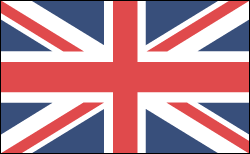
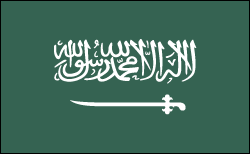 اللغة العربية
اللغة العربية 
